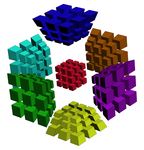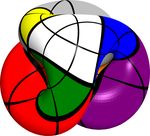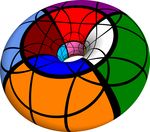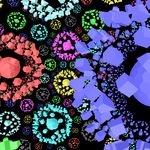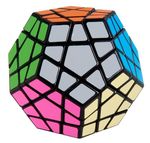Abstracting Rubik's Cube - Roice Nelson
←
→
Page content transcription
If your browser does not render page correctly, please read the page content below
Abstracting Rubik’s Cube
Roice Nelson
“The art of doing mathematics consists in Those exposed to the twisty puzzle community
finding that special case that contains all know there are many properties of the classic 3x3x3
the germs of generality” - David Hilbert Rubik’s Cube we can change to make new and interest-
ing puzzles, for example by altering the shape or the
Over the past few decades, a growing group of twist centers as in Figure 1. The hypercubing group
“hypercubists” have been discovering analogues of Ru- began by changing a more abstract property, namely
bik‘s cube, traversing a wide range of mathematical the dimension. Don Hatch and Melinda Green wrote
ground. Solving puzzles is a core pastime, but this an exquisite working 4-dimensional 3x3x3x3 (or 34 )
group is about much more. The explorations have analogue, which they called MagicCube4D. Using
been a microcosm of mathematical progress. Find- dimensional analogy, every property of this puzzle is
ing and studying natural analogues provides a rich upped a dimension. Faces, stickers, and twisting are
way to approach varied topics in mathematics: geom- 3D rather than 2D. Using a central 4D → 3D pro-
etry (higher-dimensional, non-Euclidean, projective), jection, we see the hyperpuzzle as if you are looking
group theory, combinatorics, algorithms, topology, into a box, with the nearest face hidden. Figure 2 puts
polytopes, tilings, honeycombs, and more. Elegance the 3D and 4D puzzles side-by-side to emphasize the
is a core principle in the quest. analogy.
(a) “Megaminx” uses a do- (b) The “Helicopter Cube” (a) The 33 , projected so (b) The 34 , projected so a
decahedral shape rather than twists around edges instead a 2-dimensional “flatlander” 3-dimensional being sees 7
a cube. of faces. sees 5 of the 6 cube faces. of the 8 hypercube faces.
Figure 1: We begin abstracting Rubik’s cube as soon as Figure 2: Dimensional analogy and projection tricks can
we change some property. help us understand higher dimensional Rubik’s Cubes.The 33 Rubik’s Cube has 6 × 32 = 54 stickers 3 dimensions, but 6 perfectly regular shapes a dimen-
that can live in a mind-boggling 4.325 × 1019 possi- sion up, and you can attempt to solve twisty puzzle
ble states. The hypercubical 34 has 8 × 33 = 216 versions of all of them! Figure 4 shows one of the
stickers and the number of possible puzzle positions most beautiful in its pristine state.
explodes to an incomprehensible 1.756 × 10120 . Cal-
culating this number is a challenge that will test your
group theory mettle!
“In that blessed region of Four Dimen-
sions, shall we linger on the threshold of
the Fifth, and not enter therein?” - Edwin
Abbott, Flatland
The group didn’t stop there. In 2006, a working
5-dimensional puzzle materialized with 10 × 34 =
810 hypercubical stickers and 7.017 × 10560 states,
pushing the boundaries of visualization. The picture
on the screen is effectively a shadow of a shadow
of a shadow of the 5D object. Nonetheless, as of
mid 2017, around seventy individuals have solved this
puzzle. In June 2010, Andrey Astrelin stunned the
group by using a creative visual approach to represent Figure 4: Magic120Cell, or the “4D Megaminx” has 120
a 7-dimensional Rubik’s Cube. Yes, it has been solved. dodecahedral faces. It derives from the 120-Cell, one of 6
Platonic shapes in 4 dimensions.
Can you calculate the number of stickers on the 37 ?
You may also enjoy using dimensional analogy to
Shapes in arbitrary dimensions are called poly-
work out the properties of a 2-dimensional Rubik’s
topes, or polychora in 4 dimensions. In addition to
Cube. What dimension are the stickers?
the regular polychora, there are many uniform poly-
chora and quite a few have been turned into twisty
puzzles. Uniform polychora can break regularity in
various ways. They may have multiple kinds of 3D
faces or the faces may be composed of uniform (a.k.a.
Archimedean) polyhedra.
“For God’s sake, I beseech you, give it
up. Fear it no less than sensual passions
because it too may take all your time and
deprive you of your health, peace of mind
and happiness in life.”
No, these were not desperate pleas to a hypercu-
bist about excessive puzzling adventures. Such were
the words of Farkas Bolyai to his son János, discour-
Figure 3: A shadow of a shadow of a shadow of the 35 . aging him from investigating Euclid’s fifth postulate.
Stickers are little hypercubes. János continued nonetheless, which led him into the
wonderful world of hyperbolic geometry. We also did
Of course we can play the same game of chang- not heed the advice.
ing the shape in higher dimensions to yield a panoply Let’s use topology to abstract away a different
of additional puzzles. There are 5 Platonic solids in property of Rubik’s Cube - its cubeness. To do this,we project the cube faces radially outward onto a conformal, or angle preserving, maps. Stereographic
sphere. Mathematicians label the sphere S 2 because projection is a conformal map for spherical geometry.
they consider it a 2-dimensional surface rather than Its analogue for hyperbolic geometry is the Poincaré
a 3-dimensional object. Notice in Figure 5a that al- disk, which squashes the infinite expanse of the hyper-
though the familiar cubeness is gone, all of the impor- bolic plane into a unit disk. These models have many
tant combinatorial properties remain. Furthermore, beautiful properties and the isometries (transforma-
what were 2-dimensional planar slices of the Rubik’s tions which preserve length) of all 3 models can be
cube are now 1-dimensional circles on the spherical described via a simple mathematical expression that
surface. A twist simply rotates the portion of the
surface inside one of these “twisting” circles.
In short, we are considering the Rubik’s cube as
a 2-dimensional tiling of the sphere by squares, sliced
up by circles on the surface. Why? Because we can
then consider other colored regular tilings and a huge
number of new twisty puzzles become possible, some
living in the world of hyperbolic geometry!
(a) Torus Rubik’s cube on the (b) Torus Rubik’s cube
Euclidean universal cover. mapped to the Clifford torus.
(a) Radially projected to the (b) Stereographically pro-
sphere, S 2 . jected from the sphere to the
complex plane.
Figure 5: The Rubik’s cube viewed as a 2-dimensional
tiling on a surface.
In 2 dimensions, there are three geometries with (c) Klein bottle Rubik’s cube (d) Klein bottle Rubik’s cube
on the Euclidean universal mapped to a Lawson Klein bot-
constant curvature: spherical, Euclidean, and hyper- cover. tle.
bolic, and each can be tiled with regular polygons.
These geometries correspond to whether the interior
angles of a triangle sum to greater than, equal to, or
less than 180 degrees, respectively. The Schläfli sym-
bol efficiently encodes regular 2-dimensional tilings in
all of these geometries with just two numbers, {p, q}.
This denotes a tiling of p-gons in which q such poly-
gons meet at each vertex. For example, {4, 3} denotes
the tiling of squares with three arranged around each
vertex, i.e. the cube. The value of (p − 2)(q − 2) (e) Hemi-icosahedron (or real (f) Hemi-icosahedron Rubik’s
projective plane) Rubik’s cube cube mapped to the Bryant–
determines the geometry: Euclidean when equal to 4,
on the spherical universal Kusner parametrization of
spherical when less, and hyperbolic when greater. cover. Boy’s surface.
Euclidean geometry is the only one of the three
that can live on the plane without any distortion. A Figure 6: Example tiling analogues. Note that there are
other tilings that can also map to the surfaces on the right.
lovely way to represent the others on the plane is viaacts on the complex plane: the Möbius transforma- “We live on an island surrounded by a
tions. sea of ignorance. As our island of knowl-
az + b edge grows, so does the shore of our ig-
f (z) = norance.” - John Archibald Wheeler
cz + d
You may have noticed that we have with another There are quite a few intriguing analogues that
problem to make puzzle analogues workable for Eu- I have not been able to describe here. Let me just
clidean and hyperbolic tilings. Spherical tilings are mention two of my favorite abstractions, shown in
finite, but tilings of the other two geometries go on Figure 8. The first is another astonishing set of puz-
forever. To overcome this final hurdle, we take a fun- zles by Andrey are based on the {6, 3, 3} honeycomb
damental set of tiles and identify edges to be glued in 3-dimensional hyperbolic space, H3 . The faces
up into a quotient surface. This serves to make the are hexagonal {6, 3} tilings, with 3 faces meeting at
infinite tilings into finite puzzles. Figure 6 show but a each edge. Gluing via identifications serve to make
few examples. We can even glue up a subset of tiles the underlying honeycomb finite in two senses: the
on the sphere, as in Figure 6e. number of faces and the number of facets per face. If
One of the crown jewels of this abstraction is we take a step back and consider where we started,
the Klein Quartic Rubik’s cube, composed of 24 hep- this puzzle has altered the dimension, the geometry,
atagons, three meeting at each vertex. It has “center”, and the shape compared to the original Rubik’s cube!
“edge”, and “corner” pieces just like Rubik’s cube. The second is a puzzle written by Nan Ma based
The universal cover is the {7, 3} hyperbolic tiling, on the 11-cell, an abstract regular polytope composed
and the quotient surface it is living on turns out to be a of eleven hemi-icosahedral cells. You might consider
3 holed torus. This results in some solution surprises; this a higher dimensional cousin of the Boy’s surface
if you solve layer-by-layer as is common on the Ru- puzzle we met earlier. The 11-cell can only live geo-
bik’s cube, you’ll find yourself left with two unsolved metrically unwarped in ten dimensions, but Nan was
faces at the end instead of one. able to preserve the combinatorics in his depiction.
With so many puzzles having been uncovered,
one could be forgiven for suspecting there is not much
more to do. On the contrary, there are arguably more
avenues to approach new puzzles now than ten years
ago. For example, there are no working puzzles in
H3 composed of finite polyhedra. There are not yet
puzzles for uniform tilings of euclidean or hyperbolic
geometry, in 2 or 3 dimensions. Uniform tilings are
not even completely classified, so further mathemat-
ics is required before some puzzles can be realized.
Melinda has been developing a physical puzzle that
is combinatorially equivalent to the 24 . The idea of
fractal puzzles have come up, but no one has yet been
able to find a good analogue.
In addition to the search for puzzles, countless
mathematical questions have been asked or are ripe
Figure 7: Klein Quartic Rubik’s cube on the hyperbolic for investigation. How many permutations do the
universal cover. The quotient surface is a 3 holed torus. various puzzles have? What checkerboard patterns
are possible? Which nd puzzles have the same number
All of these puzzles and more are implemented in of stickers as pieces? How many ways can you color
program called MagicTile. The puzzle count recently the faces of the 120-Cell puzzle? What is the nature of
exceeded a thousand, with literally an infinite number God’s number for higher dimensional Rubik’s cubes?
of possibilities remaining. The avenues seem limited only by our curiosity.The following papers are freely available online:
Kamack, H. J., and T. R. Keane. ”The Rubik
Tesseract.” (1982).
Stillwell, John. ”The Story of the 120-cell.” No-
tices of the AMS 48.1 (2001).
Séquin, Carlo H., Jaron Lanier, and UC CET. ”Hy-
perseeing the regular Hendecachoron.” Proc ISAMA
(2007): 159-166.
Roice is a software developer with a passion for ex-
ploring mathematics through visualization. He enjoys
spending time with his soul-mate Sarah and their three
cats, and prefers traveling on two or fewer wheels.
(a) Magic Hyperbolic Tile {6, 3, 3}. This is an in-space view
of the puzzle in 3-dimensional hyperbolic space.
This is a preprint of an article published by Taylor &
Francis Group in Math Horizons on March 7, 2018,
available online: Abstracting the Rubik’s Cube.
(b) Magic 11-Cell. Here we see the puzzle scrambled.
Figure 8: Two extremely exotic Rubik’s cube abstractions.
Furthur Exploration
MagicCube4D website
Contains links to all the puzzles in this article and the
hypercubing mailing list.
Burkard Polster (Mathologer) produced wonderful
introductory videos to MagicCube4D and MagicTile.
Cracking the 4D Rubik’s Cube with simple 3D tricks
Can you solve THE Klein Bottle Rubik’s cube?You can also read





